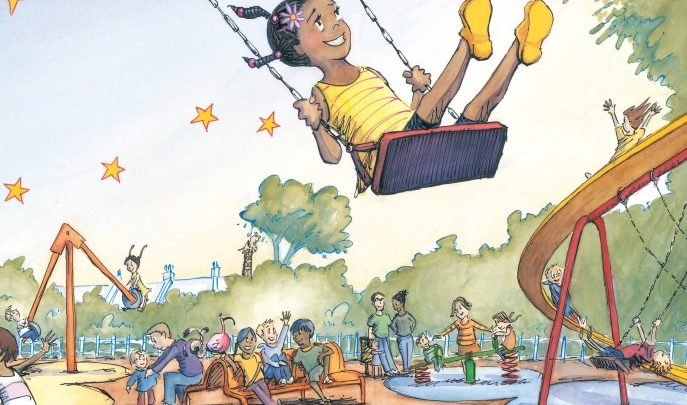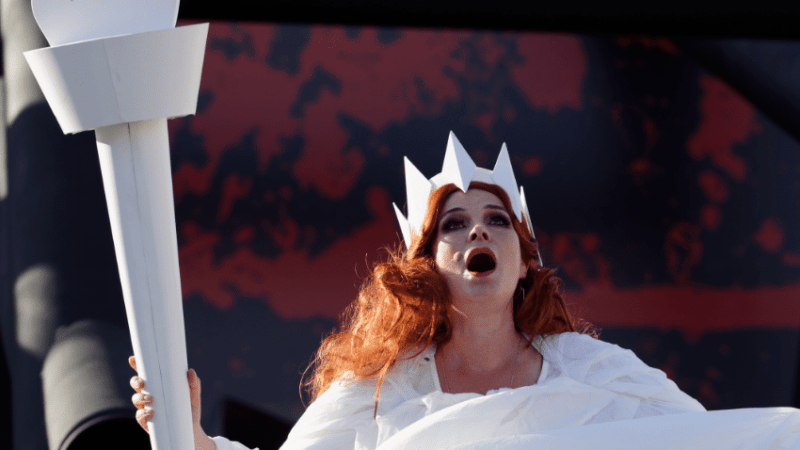Use Free Play And Imagination With This KS1 Book Topic – Ruby Nettleship And The Ice Lolly Adventure

A mysterious ice lolly that, when planted, transforms a run-down inner city playground into a sprawling adventure garden is an irresistible theme for a KS1 topic…

- by Sue Walters

Ruby Nettleship and the Ice Lolly Adventure is a beautiful picture book that’s full of optimism.
Its eponymous central character provides a wonderful role model and the detailed illustrations, which demand repeat viewings, reflect the rich cultural and social mix of British cities.
The story emphasises the importance of free play and imagination, as well as the power of children to influence change, which opens up plenty of creative pathways to be explored in the classroom.
1. The plot
When the final working swing at their dilapidated playground breaks, the waiting children head sadly for home.
Everyone except Ruby, that is, who hangs around thinking about how the playground really ought to be.
Surprised by the arrival of an ice cream van, Ruby explains the problem to the lady behind the counter who cheers her up with a free lolly; which turns out to have the words ‘plant me’ written on the stick. Following the instructions, Ruby is amazed to find the lolly springs to life, growing rapidly into an enormous vine that creates an ever-changing, constantly expanding play space. Gathering her friends on the way, Ruby is swept along on a dream-like adventure as the magical playground spills out into the city, taking children, zoo animals, shoppers and traffic along with it – heading straight for the town hall and the Mayor’s office door!
Ruby takes a deep breath and heads right in, where she finds a strangely familiar-looking Mayor who works some more magic for Ruby and her friends in a slightly more practical way, changing their park play space for good.
2. Introducing the book
Before you read the story to the class, draw them into the tale by making each child a ‘magic’ ice lolly.
Prepare frozen fruit juice lollies in advance with the “plant me” message on each wooden stick.
As the children eat their lollies, just wait to see who notices the hidden message. Ask them what might happen if they follow the instruction? What will grow? Will it be a plant, an object, a building, a creature? Really encourage your children to let their imaginations run wild and draw and label their ideas.
3. Step inside the story
There’s so much for the children to discover in the book’s illustrations that it is a real gift for talk, leading on to written work that will buzz with excitement.
Taking a trip to your local park to collect words is a great way to get the ball rolling. Stand at the bottom of a slide and film or photograph your children as they slip down. Challenge them to each think of different words (verb/adjective/adverb) to describe the experience and say it to camera.
Repeat this with the swings, roundabout etc and review the film back at school, talking about the language and the experience. Can you add any new vocabulary? Next, invite the children to imagine they can step into one of the pictures in the book. (The busy double-page spread showing the centre of the town would be a good one to use.) Ask them:
• What can you see? • What can you hear? • What can you touch and what would it feel like? • What can you smell? • How does it make you feel?
Encourage lots of detail and excitement.
Draw a story map showing where Ruby is taken on her playground adventure.
Ask what might happen if the plant grew into your school? Who might it pick up on the way? Walk around looking at different spaces in the building and discuss what might happen. Which pieces of equipment might join the roller coaster? (Refer to the questions you used when stepping inside the picture and draw on your experiences at the park.)
Children can use these ideas to start a new story. Ask them where else they think the plant might go? Then draw a story map and let it grow!
4. What are they saying?
Look carefully at the faces of the children in the picture of the park at the start of the book – how are they feeling? And what are they saying to each other/thinking?
In groups, dramatise the queue in the park: • To begin with, practise pulling faces to show different emotions: happiness, anger, sadness, boredom, confusion or misery.
• Re-create the queue for the final working swing. Re-read the extract from the book that describes the broken play equipment and the long wait ending with the swing breaking and there being nothing left to play on. Ask the children to show on their faces how they feel.
• Ask the children to ‘freeze’ then use ‘touch and tell’ to see how each child is feeling. When the teacher touches a child they ‘come to life’ and say what they are feeling / thinking. Record their responses and talk about them as a class.
• Give everyone paper speech and thought bubbles to record their words or sentences and display these around the picture of the park. Use this experience to prepare for writing in role as one of the disappointed children – pupils can write an account of what had happened at the park before going home and leaving Ruby there alone.
5. Change your playground
This book links beautifully to looking at your own environment and identifying potential changes. As with some of the writing outcomes, a great place to start would, of course, be your local playground – don’t forget to take this book along with you and read it while you’re there.
What is in your local playground? Ask children to take photos, give them printed copies and ask them to label these with notes about the equipment they like, or information about what isn’t working, is unsafe or shabby. How does it compare with Ruby’s playground? What changes would they like to see? (use the book to help with ideas, looking carefully at the magical playground as well as the ‘real’ one at the end.) Who else uses the park? What changes would they like to see (ask family, neighbours, friends)? Investigate other parks nearby.
Armed with all this information, children can now move on to design their own fantasy playgrounds.
Ruby Nettleship is also lovely starting point for a growing activity. If you have an outdoor space, why not find out about planting a willow withy structure (tunnel, wigwam, arch, etc)? As this involves planting sticks that spring to life, it’s the nearest thing to Ruby’s magical ice lolly plant that you can actually create. Don’t forget to hide interesting objects or creatures in there to stimulate imagination, talk and writing.
6. Dance the story
Create a piece of dance which tells part of the story, starting with the vine growing and ending as it shrinks back into the ground again. Start off by collecting movement words from the book, from your playground writing and from your own ideas about how the vine moves and grows. Look at pictures of tendrils and stems on vines – or even the real thing – and practise making curling, twisting, unfurling movements with hands, arms, legs, feet. Extend these into whole body movements Use strips of ribbon and lightweight fabrics to emphasise the shapes, turns and patterns created by the vine, starting slowly as it sprouts from the lolly stick, and continuing with variation of speed and level; sometimes allowing the fabric shapes to lead the movement, sometimes letting the children’s own movements lead. Include points at which the children freeze momentarily, so the focus is on their own body shape. Add in a larger piece of lightweight cloth (e.g. voile) to flap and roll under, to run with and float over other children. Or use a piece of Lycra to stretch, roll up into and unroll, bounce off, changing the quality of movements. Change pace again at the end of the dance, slowly sinking to the ground and curling up as the vine finally dies back.
7. Organise a picnic
Plan a special celebratory performance visit to your local park. Design invitations to send to families and involve the children in acting out parts of the story in situ as you re-read the book for the final time. Incorporate movements from their dance and finish with lots of fun on the real playthings and a picnic.
Book talk
One of the most important things you can do to promote reading for pleasure is talking regularly about books. Value everyone’s ideas, however unusual! Some ideas for questions include: • How does the story make you feel? Why? What’s your favourite part and why? • Which of the characters was the funniest? The most unusual? • Do you like the cover? Why / why not? • Who do you think this story is for? • What is the best word in the whole book? Why? • Which is your favourite illustration in this book? Why?










